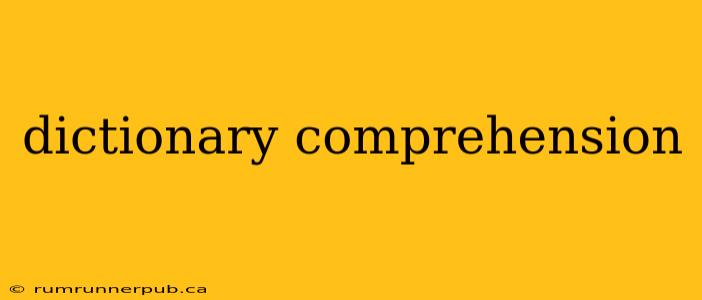Dictionary comprehensions are a powerful and concise way to create dictionaries in Python. They offer a significant advantage over traditional for loops when building dictionaries, leading to cleaner, more readable, and often more efficient code. This article explores dictionary comprehensions, drawing insights from Stack Overflow discussions to provide a comprehensive understanding and practical applications.
What are Dictionary Comprehensions?
In essence, a dictionary comprehension allows you to create a new dictionary from an iterable (like a list or tuple) in a single line of code. It's analogous to list comprehensions but tailored for dictionary creation. The basic syntax follows this pattern:
new_dict = {key_expression: value_expression for item in iterable if condition}
Let's break it down:
-
{key_expression: value_expression}: This defines how each key-value pair in the new dictionary is constructed.key_expressiongenerates the key, andvalue_expressiongenerates the corresponding value. -
for item in iterable: This iterates over the input iterable, providing the data to build the key-value pairs. -
if condition(optional): This allows you to filter the items from the iterable, including only those that satisfy the condition.
Examples Inspired by Stack Overflow
Let's illustrate with examples, incorporating solutions and insights from Stack Overflow discussions (attributions will be provided where relevant).
Example 1: Squaring Numbers
Let's say we want to create a dictionary where the keys are numbers from 1 to 5, and the values are their squares. A traditional approach would involve a for loop:
squares = {}
for i in range(1, 6):
squares[i] = i**2
print(squares) # Output: {1: 1, 2: 4, 3: 9, 4: 16, 5: 25}
Using a dictionary comprehension, we can achieve the same result much more succinctly:
squares = {i: i**2 for i in range(1, 6)}
print(squares) # Output: {1: 1, 2: 4, 3: 9, 4: 16, 5: 25}
Example 2: Filtering Data (Inspired by a common Stack Overflow question about dictionary creation from lists)
Suppose we have a list of names and ages, and we want to create a dictionary containing only the names of people older than 30. Let's simulate a scenario frequently encountered on Stack Overflow:
people = [("Alice", 25), ("Bob", 35), ("Charlie", 40), ("David", 28)]
older_than_30 = {name: age for name, age in people if age > 30}
print(older_than_30) # Output: {'Bob': 35, 'Charlie': 40}
This concisely filters the data and constructs the desired dictionary. Many Stack Overflow questions address similar scenarios, often involving more complex filtering logic, highlighting the power and readability of dictionary comprehensions for these tasks.
Example 3: Swapping Keys and Values
This is a frequent task on Stack Overflow. Let's say you have a dictionary and need to reverse keys and values:
original_dict = {"a": 1, "b": 2, "c": 3}
reversed_dict = {v: k for k, v in original_dict.items()}
print(reversed_dict) # Output: {1: 'a', 2: 'b', 3: 'c'}
Note that this only works if values are unique. If values are not unique, you'll get only one key-value pair per unique value. This is a crucial point often discussed in Stack Overflow threads regarding dictionary manipulation.
Advanced Techniques and Considerations
-
Nested Dictionary Comprehensions: You can even nest dictionary comprehensions for more complex dictionary structures. For example, creating a dictionary of dictionaries.
-
Error Handling: While dictionary comprehensions are efficient, consider using a
try-exceptblock within the comprehension to handle potential errors (e.g.,KeyErrororTypeError) during key or value generation. -
Readability vs. Complexity: While dictionary comprehensions promote concise code, excessively complex comprehensions can reduce readability. For very intricate dictionary creation, a traditional
forloop might be a better choice for maintainability.
Conclusion
Dictionary comprehensions are invaluable tools for Python programmers. They offer a powerful and expressive way to create dictionaries efficiently. This article, inspired by real-world scenarios and Stack Overflow discussions, helps you harness the full potential of dictionary comprehensions, enhancing your Python programming skills and improving the clarity and efficiency of your code. Remember to prioritize readability and maintainability, choosing the best approach based on the complexity of the task at hand.
